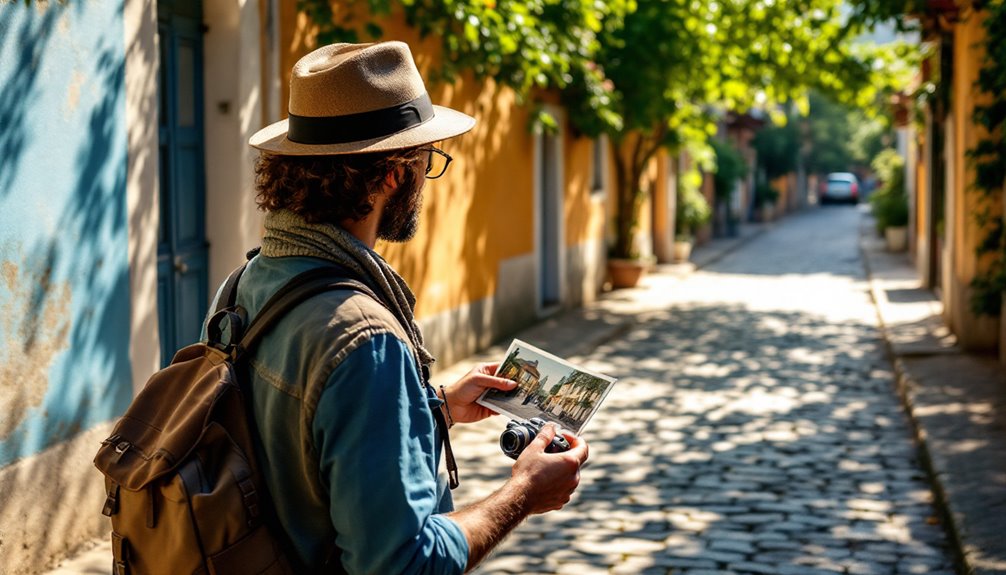You might not realize that flashbacks can transform your travel narrative from a mere recounting of places into a rich fabric of emotions and memories. When you weave these glimpses into the past seamlessly into your journey, you create a deeper connection for your audience. Think about the moments that shaped your travels—how can they enhance your current experiences? Understanding the nuances of timing and placement could make all the difference in your storytelling approach. So, how do you guarantee these memories amplify rather than distract from your narrative?
Understanding Flashbacks in Travel Writing
How do flashbacks enhance your travel writing? They add depth and emotional resonance to your narrative by connecting your present experiences with past memories. When you vividly describe a sensory trigger—a familiar smell or sound—it can transport you and your readers back in time. Picture catching a whiff of lilacs while you stroll through a garden; suddenly, you’re reminded of a childhood summer spent at Grandma’s house. That’s the power of flashbacks! Additionally, purposeful flashbacks must enhance the narrative’s overall experience, ensuring they serve a clear function in your storytelling.
To make your flashbacks effective, confirm they’re triggered by something in the present. This keeps the shift smooth and organic, allowing readers to feel what you felt. A simple phrase like “I remembered” can signal a change from the present to the past, while altering verb tense helps clarify the timeline. Keep those flashbacks brief and relevant; you want them to enhance the story, not bog it down with unnecessary details.
Timing and Placement Strategies
When’s the right moment to weave in flashbacks during your travel writing? Timing is everything. You want to ground your readers in the present before slipping into the past. Introduce flashbacks after key plot points to provide depth or explain motivations. Think of them as your emotional secret sauce, adding cultural context and emotional resonance to your narrative.
Avoid starting with flashbacks; they can confuse readers who are still trying to get their bearings. Instead, let an external stimulus trigger your flashback. This keeps it relevant and engaging. Flashbacks should be brief and focused, revealing key moments that enhance character development or advance the plot. Flashbacks represent layers of memory that add complexity to your storytelling.
When you do include a flashback, orient readers quickly—let them know where and when they are within the first few sentences. Use section breaks or clear shifts to signal the return to the main story, avoiding any narrative whiplash.
Effective Transition Techniques

After mastering the timing and placement of flashbacks, the next step is to guarantee your readers navigate these changes smoothly. You can do this by using specific connecting phrases that signal a shift to the past, like “Years ago” or “He had been nine years old.” Avoid clichés such as “The memory played in his mind as if it were yesterday…” because they can pull readers out of the moment.
Remember to adjust your verb tense appropriately. When you’re moving into a flashback, shift from present to past perfect tense, then switch to past tense once the flashback is established. This keeps everything consistent and clear. For instance, if you’re writing in the present tense, past perfect works wonders to draw readers into the memory. Additionally, using transitional words can enhance the smoothness of your narrative shifts, guiding readers through the changes in time and perspective.
Anchors, like a familiar object or a specific moment, can help trigger the flashback, connecting the present scene with the past. Use sensory details to create a vivid experience, but don’t overdo it—keep changes brief and focused to maintain the narrative flow. With a little practice, your changes will feel natural, enhancing your travel writing without leaving readers scratching their heads.
Triggering Meaningful Flashbacks
What stirs a memory deep within you, prompting a flashback that feels both vivid and essential? Often, it’s the subtle sensory triggers around you that release those moments. Maybe it’s the crisp scent of lilacs wafting through the air, instantly transporting you to a cherished Mother’s Day from your childhood. Or perhaps you hear a familiar song that takes you back to a snowy day when you bumped into an old flame, your heart racing as emotions resurface.
These triggers should resonate emotionally, connecting past experiences to your current narrative. Think about a location that holds significance—walking through a familiar park might remind you of laughter shared with a long-lost friend. Even a random object, like an old photograph, can spark a journey down memory lane, revealing layers of your character’s backstory. Flashbacks can enrich the narrative by providing deeper context and understanding of character motivations.
Keeping Flashbacks Concise

Crafting effective flashbacks requires precision, ensuring they enhance rather than detract from your narrative. Focus on moment selection; choose a key event that resonates emotionally. Instead of diving into lengthy backstories, summarize when necessary, highlighting only essential details that impact the present story. This keeps readers engaged and prevents them from feeling overwhelmed.
When you shift to a flashback, signal the change clearly. Use transitional phrases to mark the time alteration, keeping your audience oriented and grounded in the current plot. Remember, your flashback should relate to the character’s emotions or situation, maintaining relevance and avoiding confusion. Effective triggers such as scents or sounds can act as catalysts for the flashback, enriching the emotional landscape.
Keep your language concise. Cut out any unnecessary scenes or dialogue that don’t serve a specific purpose. Each flashback should feel like a well-placed puzzle piece, adding depth without disrupting your story’s pace.
Lastly, use flashbacks sparingly. Overusing them can confuse readers and distract from your main narrative. Always ask yourself if each flashback genuinely enhances the emotional impact or character development. If it doesn’t, it’s time to hit the editing room floor!
Advancing the Storyline
Flashbacks can greatly advance your storyline when used thoughtfully. Visualize you’re walking through a bustling market, and the scent of fresh cinnamon suddenly pulls you back to your grandmother’s kitchen. That’s a sensory trigger, sparking personal reflections that not only enrich your narrative but also deepen the reader’s connection to your experience. It’s vital that these triggers tie directly into your story, enhancing the present moment and giving context to your feelings or actions.
To make your flashbacks effective, shift smoothly. You might alter the tense or signal the change with a phrase like, “I remembered…” This way, your readers won’t need a map to find their way back to the present. Instead, they’ll feel just as engaged in your memories as you are. Using descriptive writing allows you to paint vivid images that transport readers alongside you in those moments.
And remember, flashbacks aren’t just for decoration; they reveal important information. Whether it’s explaining why you’re scared of the sea or showing how a past trip shaped your outlook, every flashback should serve a purpose. By weaving these moments into your travel writing, you’ll not only advance your storyline but also create a richer, more engaging experience for your readers.
Ensuring Clarity and Engagement

Effective travel writing hinges on clarity and engagement, especially when incorporating flashbacks. To guarantee your readers stay connected, use clear shifts that act like a “magical door” into the past. For instance, you might have a character pause to observe a cherished object that triggers a memory. Phrases like “he remembered” can smoothly signal this change, transporting readers to those memorable moments. Keep your flashbacks brief and focused, highlighting sensory experiences that engross readers in the scene. Descriptive language makes the past come alive—think of the smell of street food or the sound of waves crashing.
Incorporating sensory details within your flashbacks can significantly enhance the reader’s immersion in the scene. When it’s time to return to the present, use transitional phrases that remind readers of where they are. For example, “Now he was stranded on the side of the road.” This helps avoid confusion and keeps the narrative flowing smoothly. Remember, don’t overdo it with flashbacks, as they can feel like a storytelling cop-out. Instead, use them strategically, triggered by present experiences to maintain relevance. By balancing clarity with engagement, your readers will feel like they’re part of the adventure, not just bystanders.
People are Asking
How Do Cultural Differences Affect the Perception of Flashbacks?
Cultural differences shape your perception of flashbacks by influencing how you interpret narrative structure and cultural context. Recognizing these nuances enhances authenticity, allowing you to convey richer, more meaningful memories that resonate with diverse audiences.
Can Flashbacks Enhance the Emotional Impact of Travel Experiences?
Absolutely, flashbacks can enhance the emotional impact of travel experiences. They create emotional resonance, adding narrative depth by connecting past memories with present moments, making your journey feel richer and more meaningful.
What Genres of Travel Writing Benefit Most From Flashbacks?
Nostalgic journeys in travel writing often thrive on flashbacks, enriching personal narratives. Genres like memoirs and reflective writing benefit most, as they weave past experiences into the present, deepening emotional connections and enhancing storytelling’s overall impact.
How Can I Avoid Clichés in My Flashbacks?
To avoid clichés in your flashbacks, focus on unique narratives and employ memory techniques. Use specific details and personal experiences, allowing the reader to connect deeply without relying on generic or overused imagery.
Are There Specific Travel Destinations That Inspire More Flashbacks?
Certain travel destinations evoke nostalgic landscapes that inspire significant memories. Places tied to pivotal life events or sensory experiences, like unique foods or sounds, can trigger powerful flashbacks, making your travels even more meaningful.
Wrapping up
So, while you weave your travel tales, remember that flashbacks can be like a time machine, instantly transporting readers to moments that matter. Use them wisely, timing your memories just right, and sprinkle in those sensory triggers to make your stories pop. Keeping things concise helps maintain clarity, while engaging changes keep your audience hooked. With a bit of practice, your travel writing can become a enthralling journey, leaving readers dreaming of their next adventure!